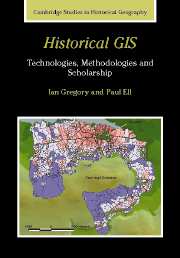Book contents
- Frontmatter
- Contents
- List of figures
- List of tables
- Acknowledgements
- 1 GIS and its role in historical research: an introduction
- 2 GIS: a framework for representing the Earth's surface
- 3 Building historical GIS databases
- 4 Basic approaches to handling data in a historical GIS
- 5 Using GIS to visualise historical data
- 6 Time in historical GIS databases
- 7 Geographic Information Retrieval: historical geographic information on the internet and in digital libraries
- 8 GIS and quantitative spatial analysis
- 9 From techniques to knowledge: historical GIS in practice
- References
- Index
9 - From techniques to knowledge: historical GIS in practice
Published online by Cambridge University Press: 23 June 2009
- Frontmatter
- Contents
- List of figures
- List of tables
- Acknowledgements
- 1 GIS and its role in historical research: an introduction
- 2 GIS: a framework for representing the Earth's surface
- 3 Building historical GIS databases
- 4 Basic approaches to handling data in a historical GIS
- 5 Using GIS to visualise historical data
- 6 Time in historical GIS databases
- 7 Geographic Information Retrieval: historical geographic information on the internet and in digital libraries
- 8 GIS and quantitative spatial analysis
- 9 From techniques to knowledge: historical GIS in practice
- References
- Index
Summary
9.1 INTRODUCTION
The previous chapters have largely talked about the theory of using GIS in historical research, focusing on the tools that GIS has to offer and how these can and should be implemented. In this final chapter, we explore how researchers have actually used it to better understand the historiographical topic that they are interested in. To a certain extent, this is a rather limited review because, although historical GIS has been around since the late 1990s, much of the early work was concerned with the development of databases, and more recently with techniques to exploit those databases. Only relatively recently have finished papers appeared, in which the results of a GIS-based analysis make a clear contribution to our knowledge of historical geography. The papers do, however, give a clear idea of how historical GIS can and is developing our knowledge of the past, and challenging orthodox historical explanations.
In Chapter 1, we made clear that GIS had its origins in quantitative Earth Science applications. When it spread into human geography in the early 1990s, it was still largely regarded as a quantitative technology, and indeed attracted much criticism for this (see, for example, Taylor, 1990 and the essays in Pickles, 1995b). While GIS is undoubtedly a good tool for performing certain types of quantitative geography, one of the most exciting developments in recent years has been the spread of GIS into qualitative geography, an area in which historical GIS has had much to offer.
- Type
- Chapter
- Information
- Historical GISTechnologies, Methodologies, and Scholarship, pp. 183 - 204Publisher: Cambridge University PressPrint publication year: 2007



